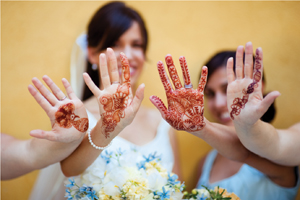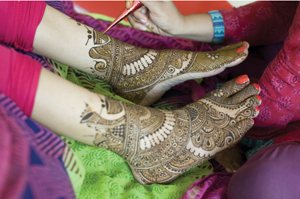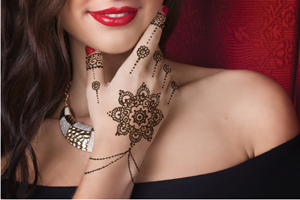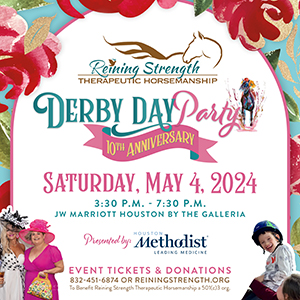Posted on May 31, 2017 in
FEATURES
 Community Culture | By Zeenat Kassam Mitha –
Community Culture | By Zeenat Kassam Mitha –
Henna is known mostly as the beautiful, semi-permanent tattoo that is adorned during an Indian, Middle Eastern or African wedding. But, what one may not know is that the beauty, art and history of henna dates back thousands of years. Due to its many purposes, henna is considered a symbol of love, good luck and security from evil. The art of henna painting on the body is customarily practiced for marriage rituals, in periods of happy occasions, during a special ceremony or during an event marking an important stage in someone’s life.
Henna’s Origins
Henna comes from the plant lawsonia inermia, which produces the leaves that make the dye in shades of red and brown. The plant is found in places such as Egypt, North Africa, India and parts of the Middle East. Once it was realized that henna had a cooling effect, painting skin with henna or placing it on hair as a dye offered a way to cool down body temperatures. This enhanced the uses of henna.
For beauty, henna is traditionally adorned on hands and feet of Indian brides. The henna is made into a thin paste called mendhi, which allows the artist to create ornate or floral intricate designs. It is applied to the bride 24 to 48 hours before the wedding, and it can last from one to three weeks depending on the strength of the mendhi. The bridal party, female family members and friends take part in decorating their hands with mendhi and welcoming the good luck associated with henna for the bride.
 Historically, over 5,000 years ago, Egyptians were ahead of their time when it came to beauty and saw the cosmetic value of this dynamic plant. They used henna as a hair dye to highlight their hair, decorate their hands and feet and paint their fingernails. When archeologists found mummies dating back to 1200 BC, the stain of henna was still on the Pharaohs’ nails and hair.
Historically, over 5,000 years ago, Egyptians were ahead of their time when it came to beauty and saw the cosmetic value of this dynamic plant. They used henna as a hair dye to highlight their hair, decorate their hands and feet and paint their fingernails. When archeologists found mummies dating back to 1200 BC, the stain of henna was still on the Pharaohs’ nails and hair.
More Than Aesthetics
Today, henna is used in a similar manner in parts of Africa, India and the Middle East as an inexpensive way to carry on the tradition began by the Egyptians. Pregnant women in Morocco often decorate their ankles with henna as a sign of protection throughout childbirth. The designs are more geometrical and are passed down for generations. In Saudi Arabia, Turkey and Iraq, the use of henna is seen as a sign of good luck. Henna has also been used on textiles to color silk, animal skins and wool, as well as on horses’ manes and hooves.
Henna Across Cultures
 In the 19th century in Europe, the aesthetic movement connected women to henna through its support for literature, fine arts and music. For example, in the late 1800s, the famous opera singer Adelina Patti was attributed with promoting the use of henna in Europe. Cora Pearl, a Parisian courtesan, dyed her hair red, inspiring the application of henna for the hair, and she was often called “La Lune Rousse,” which means “the red moon.” Elizabeth Siddal, the wife and muse of artist Dante Gabriel Rossetti, had naturally bright hair. Rosesetti portrayed her in many paintings, emphasizing her flowing, red hair. Red hair became a fetish for artists, and it is said that young women with a carefree inclination began tinting their hair with henna. Artists such as Gaston Bussiere, Evelyn De Morgan, Frederic Leighton and Frederick Sandys, along with many other Impressionist artists, further popularized henna-dyed hair and young, free spirited women through their paintings.
In the 19th century in Europe, the aesthetic movement connected women to henna through its support for literature, fine arts and music. For example, in the late 1800s, the famous opera singer Adelina Patti was attributed with promoting the use of henna in Europe. Cora Pearl, a Parisian courtesan, dyed her hair red, inspiring the application of henna for the hair, and she was often called “La Lune Rousse,” which means “the red moon.” Elizabeth Siddal, the wife and muse of artist Dante Gabriel Rossetti, had naturally bright hair. Rosesetti portrayed her in many paintings, emphasizing her flowing, red hair. Red hair became a fetish for artists, and it is said that young women with a carefree inclination began tinting their hair with henna. Artists such as Gaston Bussiere, Evelyn De Morgan, Frederic Leighton and Frederick Sandys, along with many other Impressionist artists, further popularized henna-dyed hair and young, free spirited women through their paintings.
Through growing interest in Eastern cultures in the 1950s and 1960s, henna gained admiration amongst the younger generation in the western world. For example, Lucille Ball popularized the “henna rinse” as her character, Lucy Ricardo, called it on the television show I Love Lucy.
Today in the United States, henna can be seen almost everywhere: at cultural events, at henna tattoo parlors in the mall and at local ethnic grocery stores, where it can simply be purchased over the counter. However, in the west, the idea of using henna is fairly new, and over the past decade, it has been used mostly as an art for individuality and self-expression. Application methods have also become more contemporary. Henna is also thought of as therapeutic and an opportunity for self-expression.
Western countries that practice henna as body art also use Japanese and Chinese art designs. In fact, Japanese symbols are known to be one of the most requested designs for henna. For example, the yin yang sign is one of many widespread design options in henna tattoo parlors and at henna-themed events. Many professional henna artists today work from patterns drawn from many cultures and introduce their work with a present-day, unique angle that makes the design their own. The magnificence of henna is known worldwide.














 Community Culture |
Community Culture |  Historically, over 5,000 years ago, Egyptians were ahead of their time when it came to beauty and saw the cosmetic value of this dynamic plant. They used henna as a hair dye to highlight their hair, decorate their hands and feet and paint their fingernails. When archeologists found mummies dating back to 1200 BC, the stain of henna was still on the Pharaohs’ nails and hair.
Historically, over 5,000 years ago, Egyptians were ahead of their time when it came to beauty and saw the cosmetic value of this dynamic plant. They used henna as a hair dye to highlight their hair, decorate their hands and feet and paint their fingernails. When archeologists found mummies dating back to 1200 BC, the stain of henna was still on the Pharaohs’ nails and hair. In the 19th century in Europe, the aesthetic movement connected women to henna through its support for literature, fine arts and music. For example, in the late 1800s, the famous opera singer Adelina Patti was attributed with promoting the use of henna in Europe. Cora Pearl, a Parisian courtesan, dyed her hair red, inspiring the application of henna for the hair, and she was often called “La Lune Rousse,” which means “the red moon.” Elizabeth Siddal, the wife and muse of artist Dante Gabriel Rossetti, had naturally bright hair. Rosesetti portrayed her in many paintings, emphasizing her flowing, red hair. Red hair became a fetish for artists, and it is said that young women with a carefree inclination began tinting their hair with henna. Artists such as Gaston Bussiere, Evelyn De Morgan, Frederic Leighton and Frederick Sandys, along with many other Impressionist artists, further popularized henna-dyed hair and young, free spirited women through their paintings.
In the 19th century in Europe, the aesthetic movement connected women to henna through its support for literature, fine arts and music. For example, in the late 1800s, the famous opera singer Adelina Patti was attributed with promoting the use of henna in Europe. Cora Pearl, a Parisian courtesan, dyed her hair red, inspiring the application of henna for the hair, and she was often called “La Lune Rousse,” which means “the red moon.” Elizabeth Siddal, the wife and muse of artist Dante Gabriel Rossetti, had naturally bright hair. Rosesetti portrayed her in many paintings, emphasizing her flowing, red hair. Red hair became a fetish for artists, and it is said that young women with a carefree inclination began tinting their hair with henna. Artists such as Gaston Bussiere, Evelyn De Morgan, Frederic Leighton and Frederick Sandys, along with many other Impressionist artists, further popularized henna-dyed hair and young, free spirited women through their paintings.